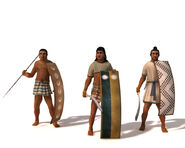Armed with big chopping swords and tall shields, Indian swordsmen are the shock infantry of Indian armies.
Description[]
Armed with big chopping swords and tall shields, Indian swordsmen are the shock infantry of Indian armies. The swords they wield have a curved shape, resembling the Greek kopis, but are bigger. They were most likely the product of Hellenic influences on Indian armament, where the Indians adapted the shape to fit other purposes as well. Hence, just like the more traditional broadswords, they would have been used as a slashing and chopping weapon in melee, the curve only increasing their effectiveness. In addition, they carry javelins which they throw before melee commences. Some javelins have barbed heads, as such heads are known both from the murals at Ajanta, and from the Epics.
The shields they carry are long and narrow and most are slightly curved. Such shields are known both from murals and reliefs, and Arrianos describes them as being narrower than a man, but almost as tall. Their size and curved shape would have almost enveloped the warrior carrying it, and given much protection from arrows. Though this type of shield is sometimes seen in other contexts, it is for the most part seen carried along with the curved swords mentioned above, and warriors thus equipped seems to have been prevalent in ancient Indian armies.
These warriors do not wear any body armour, nor do they wear helmets, making them lighter than the macemen, who make up the heavier part of the infantry, but less resilient in melee. Being Kshatriyas, many of whom are part of the standing royal army, they can afford finer clothing than the levy infantry, and some even wear jewellery. Judging by mural paintings, most would have worn white clothes with coloured patterns on, although more colourful examples are sometimes seen.
These warriors make quite good assault infantry, while their large shields make them relatively resistant to arrows and other ranged weapons. Their slashing swords may cut through most infantry, but their lack of armour may prove fatal if they are caught in prolonged melee.
Historically, swords were important weapons in India since ancient times, and already during the bronze age, the people of the Gangetic Plain wielded swords. However, with the advent of the Vedic Aryans, the sword became more associated with the knights and Kshatriyas. Though nothing is mentioned in ancient Indian sources about the Macedonian campaign in the northwest, Alexander left a lasting legacy on the military culture of the subcontinent, and the kopis sword especially was widely used. In fact, the design of the kopis sword remains in use in India today in the famed kukri knifes, which retain the shape of the Greek original. These swords were most likely adaptations of the kopis to the Indian style of sword fighting, and hence they were enlarged.
![[defaults to 250]px](https://static.wikia.nocookie.net/europabarbarorum/images/e/e7/EB2_Indian_Swordsmen.png/revision/latest?cb=20160112102801)
